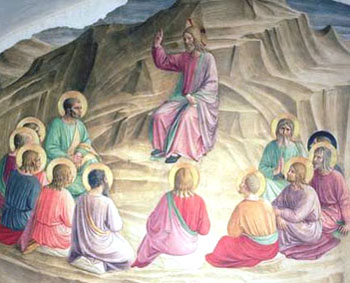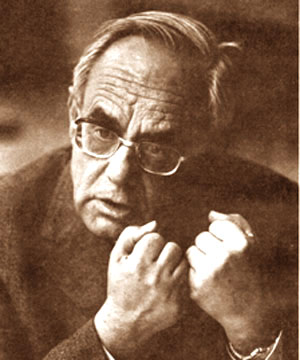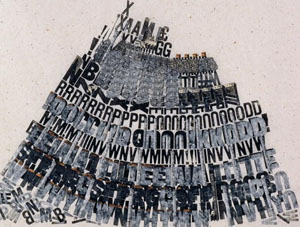 |
Consequences of Vatican II
The Language of Truth Is Simple
Lyle J. Arnold, Jr.
Commenting on the language of Our Lord, the erudite historian and exegete Fr. L.C. Fillion, S.S described His way of preaching:
"Jesus' habitual method of preaching or in simple conversation is `intuitive' rather than `discursive.' He does not reason things out, like Plato; He does not comment, like a Scribe. He knows fully and absolutely, He contemplates by direct sight. He reports what He sees and hears.

Our Lord's language was clear, concise, and simple |
“But this does not prevent His words from conforming to the ordinary laws of reasoning. His thoughts follow one another in logical order. His argumentation leaves nothing to desire. He appeals directly to the mind, the soul, the heart, sometimes His hearer's personal experience. He clearly enunciates principles and cogently deduces conclusions. And withal there shines a remarkable talent for raising minds above things of sense and the commonplace of life, transporting them to the spheres of heavenly truths and the Kingdom of God.
“Never is there a superfluous word on His lips. It is certain that His words owe part of their power to their rigorous consciousness and condensation. Everywhere they are marked by clearness and balance. Jesus makes vigorous use of irony, hyperbole and paradox."'
From her early beginnings, the Church imitated her Divine Founder in employing a clean, concise and straightforward, never confusing, language to teach her doctrine. With Vatican II, however, we saw the introduction of a new style of language, one contrary to that of Our Lord Jesus Christ. Instead of certainty, there is ambiguity; instead of conciseness, there is superfluity; instead of clarity, there is confusion.
In particular, I point out one theologian, the Jesuit Karl Rahner, who has been called the most influential theologian of the second half of the 20th century. His thinking decisively shaped Vatican II’s constitutions on the Church and on Revelation, and continued to shape the Church after the Council. His theology dominates the seminaries; he grandfathered the theologies of liberation; he redefined the missionary activity of the Church with his theory of “anonymous Christian” (we need dialogue, not conversion). (1) He was greatly admired by John Paul II and he was the mentor of the present Benedict XVI.

Rahner's language - purposely confusing and verbose |
This fuehrer of Vatican II is well known for his confusing language. His expositions – written in German - are so bewildering that his own brother Hugo, also a theologian, once noted exactly that, and then added, “I am going to spend the rest of my life translating the works of my brother into German.” (2)
For example, one can see below what Rahner has to say on the dogma of the Trinity, which he considers unacceptable to today’s man, leading to a false interpretation of God. He denies the dogma of the Most Holy Trinity by affirming – in his confused way – that the concept of one God in three Persons “has failed” and needs to be reworked:
“How can the concept of 'person' be correctly explained and interpreted? ...The self-communication of the one God takes place in three different modalities of occurrence, in which the one same God is concretely given to us. ... God is the concrete God in each of these modalities, which naturally connected in a relative way to one another but are not coincident.
“Translating this to affirm the 'immanent' Trinity, we can say that the one God subsists in three different ways of subsistence. 'Distinct way of subsistence,' then, would be the concept, not referring to the person, which designates the difference subsistent, but to the personalitas, which causes the concrete reality of God, which in each case occurs in a different way, to be what occurs precisely in that way, since that occurring-in-that-way must always be considered as belonging to God in himself. Then, the particular person (in God) would be God as existing and occurring in that determined and distinct way of subsistence. ... But if in our affirmations of faith and theology we are not satisfied with saying Father, Son, Spirit and a single God, which today is certainly not longer possible or licit, then the risk becomes inevitable." (3)
This text is pure babble, giving sufficient proof of Guimaraes’ indictment of Rahner: "He normally uses difficult language filled with many neologisms of existentialist philosophy in order to express thinking that is not always clear." (4) Often, while reading one or another of Guimaraes’ volumes of the Collection Eli, Eli, Lamma Sabacthani, the texts of Rahner that he presents are so baffling and tangled (as exemplified by the above), that I find myself in a bitter soliloquy asking, "What in the world is this clerical heretic talking about?"
The above is an example. It is so utterly arcane that it is the complete opposite of the description by Fr. Fillion at the beginning of this article about the language of Our Lord.
There is a page from one of the so-called "futuristic" novels that always seems to stay at the front of my memory. The book is the Orwellian novel 1984, and the indelible passage has to do with the subject of incomprehensible, tangled speech and power. A comparison of the passage below from 1984 with the above quote of Fr. Rahner reveals the similarities. The protagonist Winston Smith is in the canteen, listening to the nonsense speech of a man at the table next to him:

Orwellian babble - not unlike that of the Conciliar theologians |
"Because of the angle at which he was sitting, his spectacles caught the light and presented to Winston two blank discs instead of eyes. What was slightly horrible was that from the stream of sound that poured out of his mouth, it was almost impossible to distinguish a single word. Just once Winston caught a phrase — `complete the final elimination of Goldsteinism' — jerked out very rapidly and, as it seemed, all in one piece, like a line of type cast solid. For the rest it was just a noise, a quack-quack-quacking...
“As he watched the eyeless face with the jaw moving rapidly up and down, Winston had a curious feeling that this was not a real human being but some kind of dummy. It was not the man's brain that was speaking; it was his larynx.” (5)
The above babblings of Rahner are not unlike the "larynx" generated statement of Orwell, and have their own dire consequences in shaping the post-conciliar Church. Such effect confirms the validity of Guimaraes’ titles in his collection, Desire to Destroy (the Church) and Desire to Injure (the Church). These are in fact the objectives of the coup that commandeered Vatican II.
Truly, the progressivists have been enormously successful in their aim, for the power of the Conciliar Church has promulgated the worst heresy in the History of the Church, a change in the very notion of God.
To quote Prof. Plinio Corrêa de Oliveira in his work Revolution and Counter-Revolution, "Like cataclysms, the evil passions have an immense power, but that power is to destroy." (6) Truly the Conciliar Church has inflicted upon Catholics a revolution that has established a dictatorship intent on destruction.
The only hope is for the Counter-Revolution to destroy the Revolution in the Church. As Prof. Plinio notes, this is because "the most sensitive and truly decisive point in the fight between the Revolution and the Counter-Revolution has shifted from the temporal society to the spiritual one. This center has now come to be the Holy Church. Within its fabric, on the one side are the progressivists and crypto-communists and pro-communists. And these two opposing factions confront each other.” (7)
The souls that have had their minds torn to shreds, bringing them into the progressivist camp of Vatican II, must be counted in the millions. Let us redouble our prayers that Our Lady's Reign comes soon, and that our fellow Catholics once again learn the language of "Yes, Yes, No, No"' (Mt 5:37).
1. George Weigel, “The Century after Rahner,” Catholic Culture.org
2. From Chapter II of Atila Guimaraes’ Volume VII, Destructio Dei, to be released this summer.
3. Animus Injuriandi — II," Volume III of collection Eli, Eli, Lamma Sabacthani? by Atila Sinke Guimaraes, Tradition in Action, 2011, p. 152-153.
http://www.traditioninaction.org/tiabk028_AI2.htm
4. Introduction by Atila Guimarães in The Theology of Karl Rahner, S.J. by Robert C. McCarthy, Carthay Ventures, 2001, pp. x, xi.
5. George Orwell (real name Eric Blair), "1984," A Signet Classic, 1950, p. 48.
6. Revolution and Counter-Revolution, New Rochelle, The Foundation for a Christian Civilization, 1980, p. 45.
7. Ibid., 152-153

Posted May 16, 2012

Related Topics of Interest
 Deliberate Contradictions in Vatican II Deliberate Contradictions in Vatican II
 Deadly Ambiguity Deadly Ambiguity
 Is the Council under Suspicion of Heresy? Is the Council under Suspicion of Heresy?
 The Engine and Strategies of Destruction The Engine and Strategies of Destruction
 The Insidious Tactics of Change The Insidious Tactics of Change

Related Works of Interest
|
|
Vatican II | Hot Topics | Home | Books | CDs | Search | Contact Us | Donate

© 2002-
Tradition in Action, Inc. All Rights Reserved
|
 |
|